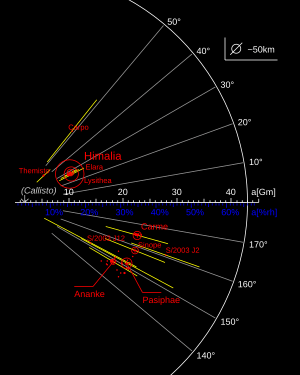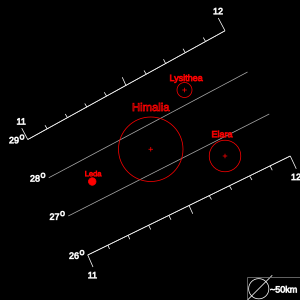Himalia group facts for kids

The Himalia group is a family of moons that orbit the giant planet Jupiter. These moons are not perfectly round, and they all travel in a similar path around Jupiter. Scientists believe they all came from the same original space rock.
These moons are called "prograde" because they orbit Jupiter in the same direction that Jupiter spins. The group is named after its largest member, Himalia.
Here are the moons known to be part of the Himalia group, listed from closest to farthest from Jupiter:
Another moon, named S/2000 J 11, might also be part of this group. Its path around Jupiter seems similar. However, its exact orbit is not fully known yet.
The International Astronomical Union (IAU) is the group that names planets, moons, and other space objects. For moons in the Himalia group, they make sure the names always end with the letter -a.
Contents
What Makes the Himalia Group Special?
The moons in the Himalia group share similar features in their orbits. An orbit is the path a moon takes around a planet.
Distance from Jupiter
These moons orbit Jupiter at a distance of about 11,150,000 to 11,750,000 kilometers. To give you an idea, that's more than 11 million kilometers away from Jupiter!
Orbital Tilt and Shape
The path of these moons is also tilted. This tilt, called inclination, is between 26.6 and 28.3 degrees compared to Jupiter's equator. Their orbits are also not perfect circles. The shape of their orbit, called eccentricity, varies from slightly oval to more stretched out.
Moon Colors and Origin
All the moons in the Himalia group look grey. They are similar in color to C-type asteroids. These are asteroids that are rich in carbon.
Scientists think that the Himalia group moons might be pieces of a larger asteroid. This original asteroid likely came from the Asteroid belt, which is between Mars and Jupiter. When this asteroid got too close to Jupiter, Jupiter's strong gravity might have pulled it apart.
The original asteroid was probably about 89 kilometers wide. Himalia, the largest moon in the group, makes up about 87% of the original asteroid's mass. This suggests that the asteroid broke apart without too much force.
See also
 In Spanish: Grupo de Himalia para niños
In Spanish: Grupo de Himalia para niños


